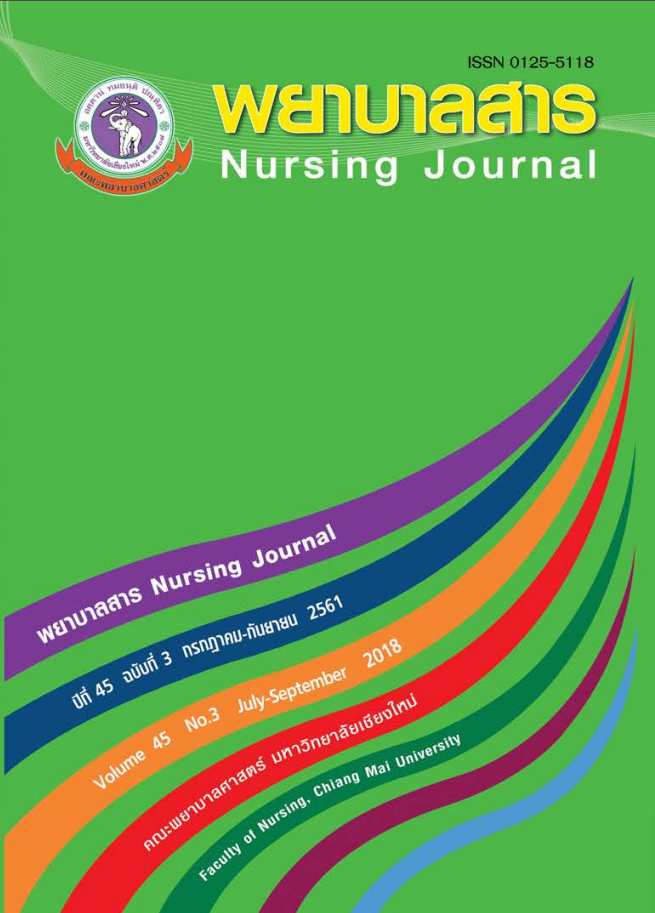Predicting Factors of Health Promoting Behaviors among Working–age adults with Dyslipidemia
Keywords:
Health Promoting Behaviors, Dyslipidemia, Working – age adultsAbstract
Dyslipidemia is a metabolic disorder of body lipoprotein. As a result, blood lipids change as a risk factor for atherosclerosis and cardiovascular disease. The mechanism of birth takes 10 years. This research was a descriptive study which aimed to examine the predictability of perceived benefits, barriers, self - efficacy, family influences, and friend influences in health - promoting behaviors among working - age adults with dyslipidemia. Samples were 228 clients who attended the Regional Health Promotion Center 10 at Ubon Ratchathani for annually health checkup were diagnosed as dyslipidemia for 20 – 59 years. The medical instruments used to collect data were questionnaires which consisted of: 1) general information 2) health promoting behaviors of working - age adults with dyslipidemia 3) perceived benefits 4) perceived barriers 5) perceived self-efficacy 6) family influences and 7) friend influences. The questionnaires were proved for content validities by five experts were tested for reliability by using Cronbach’s alpha coefficient in part 2-7 resulting in 0.73, 0.98, 0.85, 0.95, 0.70 and 0.70 respectively. General data were analyzed by using descriptive statistics. Pearson’s product moment correlation coefficient and multiple regressions were used to analyze the relations and the predictive power.
The results revealed that: the mean score in total part of health - promoting behaviors in working - age adults was at a moderate level (x̄ = 3.33, S.D. = 1.1). Perceived benefits, barriers, self-efficacy, family influences, and friend influences were significantly predicted health - promoting behaviors of working – age adults with dyslipidemia. The variables accounted for 58.7% (R2 = .587, p < .001) of total variance in the health promoting behaviors. The findings used as the knowledge for tailoring health promoting interventions in working - age adults with dyslipidemia.
References
(2001). Executive Summary of the Third Report of the National Cholesterol Education
Program (NCEP) Expert Panel on Detection, Evaluation, and Treatment of High Blood
Cholesterol in Adults (Adult Treatment Panel lll). The Journal of the American Medical.
Association, 285(19). 2486 – 2496.
Lo, S. W., Chair, S. Y., & Lee, F. K. (2015). Factors associated with health-promoting behavior of
people with or at high risk of metabolic syndrome: Based on the health belief model.
Applied Nursing Research, 28(2), 197–201.
Pender, N., Murdaugh, C., & Parsons, M. A., (2011). Health Promotion in Nursing Practice. (6th
edition). New Jersey: Upper Saddle River.
Translated Thai Referance
Sawaddipharb K. (2011). Factors Affecting Preventive Cardiovascular Behavior Among People Dyslipidemia at at Ubon Ratchathani. Master of Public Health Thesis. Branch Health promotion Faculty of Health Sciences Ubon Ratchathani Rajabhat University, Ubon Ratchathani.
Kongprasert J and Apinya T. (2015). Clinical Behavior Modification Manual NCD quality.
(Printed at 1). Nonthaburi: Agricultural Cooperatives of Thailand.
Wongrattana C. (2007). Statistics for research. (Printed at 2). Bangkok. Chulalongkorn University.
Punwet N and Chaiyawun H. (2015). World Heart Day Campaign, 2015. Office
Disease not contact the Department of Disease Control. (No year of publication).
Kornkaw P. (2011). Factors predicting health promoting behaviors of government officials with Dyslipidemia. Journal of Nursing and Health, 5(3), 17 -28.
Popha Y. (2015). Factors related to health behaviors of patients with abnormal blood lipid that can not be Controllable. Journal of Nursing, 16(1), 123 – 130.
The College of Physicians of Thailand. (2002). Guidelines for the maintenance of abnormal levels of lipids Blood. Retrieved on 22 September 2015. From http://maeprikhos.go.th/CPGonline/Dyslipidemia.pdf.
Health Promotion Hospital Health Center 10 Ubon Ratchathani. (2015).
Summary of hospital operations annual. Ubon Ratchathani: Health Promotion Hospital Health Center 10 Ubon Ratchathani.
Kumchata L. (2017). Effects of self-management programs on self-management behaviors.
Waist-level blood sugar And the risk of cardiovascular disease in those who have symptoms.
Taubolik. Nursing, 44(3), 65 – 76.
Akepalakorn W. (Editor). (2557). Thai Health Survey by Physical Examination # 5
2014. (Printed at 1). Nonthaburi: Health Systems Research Institute.
Association of arterial diseases. (2017). Medical treatment for abnormal fats.
Prevent heart disease and stroke in 2016. (Printed at 1). Pathum Thani: A - Plus.
Dangsakool S. (2015). Factors affecting the eating behavior of adolescent syndrome.
Nephrotic. Nursing . 42(2), 62 – 71.
Downloads
Published
How to Cite
Issue
Section
License
บทความที่ได้รับการตีพิมพ์เป็นลิขสิทธิ์ของวารสารพยาบาลสาร
ข้อความที่ปรากฏในบทความแต่ละเรื่องในวารสารวิชาการเล่มนี้เป็นความคิดเห็นส่วนตัวของผู้เขียนแต่ละท่านไม่เกี่ยวข้องกับมหาวิทยาลัยเชียงใหม่ และคณาจารย์ท่านอื่นๆในมหาวิทยาลัยฯ แต่อย่างใด ความรับผิดชอบองค์ประกอบทั้งหมดของบทความแต่ละเรื่องเป็นของผู้เขียนแต่ละท่าน หากมีความผิดพลาดใด ๆ ผู้เขียนแต่ละท่านจะรับผิดชอบบทความของตนเองแต่ผู้เดียว






